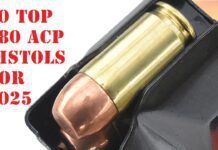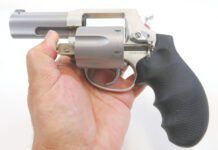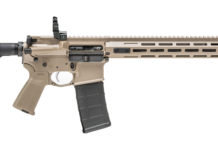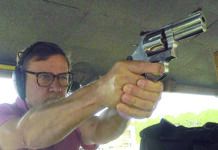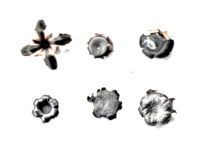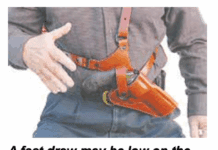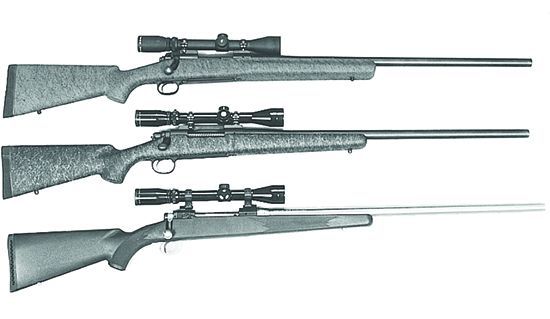In the January 1997 issue, we tested a trio of 300 Winchester Magnum bolt-action rifles intended for long-range hunting. In this installment of Gun Tests Classics, we revisit the winner of that test, a Winchester Model 70 Classic Laredo, and see if its current used pricing makes it a good choice for today’s shooters to look for in the used rack at your local gun store.
In the 1997 test, we fired a Winchester Model 70 Classic Laredo, a Remington Model 700 Sendero and a Savage Model 112 FVSS. Each gun fired 100 rounds of commercial ammunition. These rifles were designed for long-distance shooting, with heavy barrels, synthetic stocks with special action-bedding systems, and other refinements. Accuracy testing was done on an outdoor range using a sandbag rest and a variable-power scope on its highest setting.
The Remington Model 700 Sendero’s workmanship and handling were very good. It didn’t seem to care for the loads we used, but we would not rule this one out. The Savage Model 112 FVSS wasn’t as good looking or as smooth as the other rifles. However, considering this rifle’s comparatively low price, our shooters thought it performed well enough.
Winchester M70 Classic Laredo:
Best Accuracy

The Winchester Classic Laredo is a long-range bolt-action rifle that utilizes the manufacturer’s updated Model 70 pre-’64 action. In 300 Winchester Magnum, it features a heavy 26-inch barrel rifled with a 1-in-10-inch twist, a synthetic stock, a matte-blue metal finish, and an internal three-round magazine with a hinged floorplate. This model has a suggested retail price of $764. A 7mm Remington Magnum version is also available.
Our test gun’s aluminum alloy trigger guard had a matte-black finish, while the steel receiver, floorplate, bolt, and barrel had a uniform matte-blue finish. The barrel was 13⁄16-inch in diameter at the muzzle and had a recessed crown. The action locked up solidly, as did the magazine’s hinged floorplate. Other moving parts had a small amount of play.
Constructed of a fiberglass, graphite, and Kevlar composite, the one-piece stock had a dull bluish/gray finish with black veins. A machined aluminum Pillar Plus Accu Block was molded into the stock. Its black-rubber recoil pad and blued-steel swivel studs were carefully installed. The barrel floated freely, but the gap between the left side of the barrel and fore end was twice as large as the gap on the right. Otherwise, stock-to-metal mating was very good.
The Laredo was the heaviest rifle in this test and balanced an inch in front of the receiver, making target acquisition the slowest. Shouldering was also the slowest but most natural.
Due to the stock’s raised cheekpiece, we were able to establish a stockweld with very good cheek and jaw contact. The 2.30-inch-wide full beavertail fore end afforded excellent stability on a rest. It and the 1.68-inch-wide grip provided plenty of gripping area. Although felt recoil was much milder than that of a standard 300 Winchester Magnum rifle, our shooters thought this model kicked a little more than the Remington Sendero.
Excluding the trigger, this Winchester had three controls. The floorplate release, a spring-loaded catch on the front of the trigger guard, unlatched the back end of the internal magazine’s hinged floorplate when depressed. The bolt release, a small lever at the left rear of the receiver, allowed the bolt to be withdrawn from the receiver when pushed forward. Both of these controls on the rifle worked smoothly.
The three-position safety lever on the right rear of the bolt operated stiffly at first, but it smoothed out. This safety disengaged when forward, locked the firing pin only in the mid-position, and locked the bolt and the firing pin in the rearmost position.
At the range, the Laredo fed and fired all of the ammunition we tried. Extraction was smooth. Ejection was strong and consistent. The bolt’s rotation and movement were smooth. Inserting cartridges into the magazine through the ejection port in the right side of the receiver didn’t present any problems. If a round was placed directly into the chamber, the bolt wouldn’t fully close because this Winchester’s claw-type extractor wasn’t designed to slip over the rim of a cartridge.
Movement of the trigger, which had a grooved 3⁄8-inch-wide face, was clean. But all of our shooters considered it to be too heavy for long-range shooting. The pull had no slack, a crisp 6-pound release, and a small amount of overtravel.
Open sights weren’t available on this model, but the top of its receiver was drilled and tapped for a scope mount. So, for accuracy testing, we installed a Burris 3-9x Fullfield scope on the rifle using a two-piece base and a set of rings that weren’t included with the gun.
In accuracy, we felt this Winchester produced very respectable three-shot average groups with one kind of ammunition. This load, Winchester 180-grain Power Point soft points, achieved 1.28-inch groups at 100 yards. However, groups obtained using Remington 150-grain Core-Lokt PSPs and Federal Premium 200-grain Sierra GameKing boat-tail soft points averaged 2.02 and 2.10 inches, respectively.
Chronograph testing showed that muzzle velocities were satisfactory for a 300 Winchester Magnum rifle with a 26-inch barrel. Velocities averaged from 2812 fps with Federal BTSPs to 3226 fps with Remington PSPs.
Bottom Line: Although some of our shooters felt the Winchester Model 70 Classic Laredo was too heavy and bulky, it was well-made and accurate with the right ammunition. We can recommend this long range rifle.
In 2025 dollars, the Blue Book of Gun Values has the Model 70 Classic Laredo for $950 in 100% condition, $800 for 98% condition, and $625 in 95% condition. The Standard Catalog of Firearms lists this one for $750 in New In Box shape, $650 in Excellent condition, and $550 in Very Good condition. There’s a good chance a Laredo chambered in 300 Win. Mag. might not have been shot a lot, so you might find one in top condition. We think $650 is the top of our range, but we’d look hard at a Laredo that’s priced in that vein.
| WINCHESTER MODEL 70 CLASSIC LAREDO 300 WINCHESTER MAGNUM, $764 (1997) | |
|---|---|
| Action Type | Bolt |
| Finish | Blue |
| Weight (unloaded) | 10.75 lbs. |
| Overall Length | 47.0 in. |
| Barrel Length | 26.0 in. |
| Rifling Twist | 1:10 R.H. |
| Sight Radius | N/A |
| Magazine Type | Internal |
| Magazine Capacity | 3 rounds |
| Stock Composition | Synthetic |
| Stock Length of Pull | 13.75 in. |
| Stock Drop at Comb | 0.75 in. |
| Stock Drop at Heel | 0.5 in. |
| Warranty | None |





